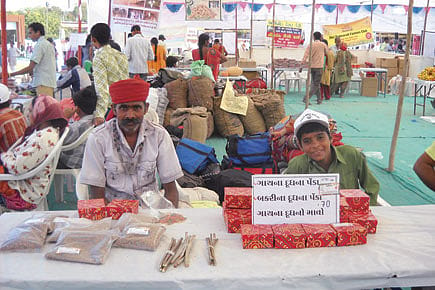Organic Food for Thought

An unusual food festival in Ahmedabad has ragi pizzas and mahua flower malpuas
The scene is crowded and festive. A little girl is howling because her mother didn't bring her on time for the drawing competition. Ladies are crowding around a stall which sells a comb that can also apply hair dye. Although the mango season was over a long time ago, customers are lapping up mango milkshake made from preserved mango pulp. People are buying recipe books. The recipes don't look like anything by Tarla Dalal or Sanjeev Kapoor. There are ragi pizzas, mahua flower malpuas and aloe vera paak. Altogether there are 60,000 people visiting in two days—40,000 adults and 20,000 children. Not bad for a food festival.
But Sattvik is not just any food festival. It takes place on IIM's new campus in Ahmedabad, and the food is made of undercultivated crops like bajra and ragi, even plants like cactus. The aim is to promote agro-biodiversity and every food item is designed to that end. Sattvik's success marks the obituary of McDonald's for IIM Professor Anil Gupta, president of the NGO Sristi which organised the fest. "We have only three McDonald's outlets in Ahmedabad anyway," he says. "The Indian mindset won't embrace readymade things. Indian men may wear readymade garments, but look at the women."
2025 In Review
12 Dec 2025 - Vol 04 | Issue 51
Words and scenes in retrospect
Alongside the 90 stalls that represent India's biodiversity are also 30 stalls selling organic products. Since the term organic is the latest buzzword in conscientious consumption, the festival organisers verified each stall's claims via a committee of consumers, NGOs and active farmers. Only direct farmers were allowed to have stalls, banishing middlemen. On display is also a small group of rural and small-scale innovators, whose innovations include objects like a non-stick mud pan, a flowerpot made of cow dung that turns into manure for the plant, and a comb with a hair dye applicator. In all, the festival hosts over 500 food preparations from across India.
"In our country, the poor eat rich food, and the rich eat poor food," says the professor. With the support of science and technology, and an urban palette for such cuisine, he dreams of creating a permanent market for food rich in biodiversity. "Wouldn't it be nice to walk into a restaurant and find menus especially designed for diabetics, for people with heart problems too?" he asks.
